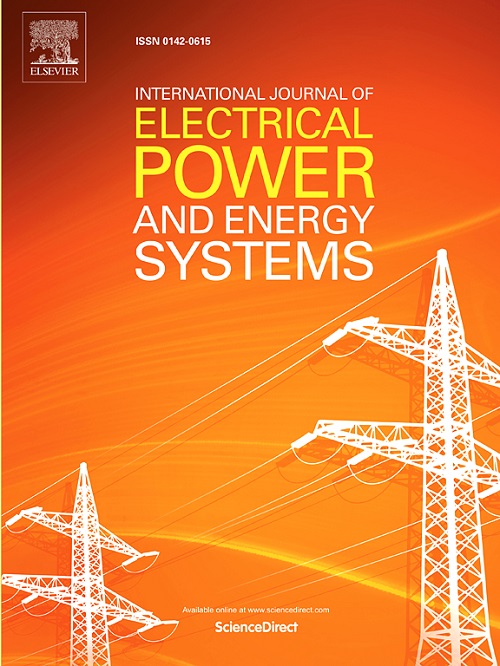A two-layer optimal dispatch model for thermal unit deep peaking shaving and dynamic line rating
IF 5
2区 工程技术
Q1 ENGINEERING, ELECTRICAL & ELECTRONIC
International Journal of Electrical Power & Energy Systems
Pub Date : 2025-09-11
DOI:10.1016/j.ijepes.2025.111098
引用次数: 0
Abstract
To address the challenges of limited system regulation and renewable energy accommodation capacity in new power system, this paper proposes a two-layer optimal dispatch model incorporating thermal unit deep peak shaving and dynamic line rating. The upper-layer model aims to minimize net load fluctuation and enhance energy storage utilization by optimizing the peak regulation schedule of thermal units through deep regulation capability, while analyzing load flow distribution. The lower-layer model calculates real-time dynamic capacity limits for overloaded transmission lines using conductor thermal balance equations and meteorological parameters, enhancing line transmission capacity to improve renewable energy utilization. The model aims to minimize system operating costs and reduce wind and PV curtailment. Taking IEEE39 as an example to verify the effectiveness of the proposed model, combined with the actual power system, it is calculated that the line capacity can be increased by up to 21.27% and 64.83% during the peak load period in different seasons, while wind and PV curtailment rates can be decreased by 4.44% and 9.43%, respectively. This model effectively reduces the consumption pressure of the system on renewable energy, promotes system stability, and lowers operating costs.
热机组深度调峰和动态线路额定值两层优化调度模型
为解决新电力系统调节能力有限和可再生能源容纳能力不足的问题,提出了一种包含热电机组深度调峰和动态线路额定值的两层优化调度模型。上层模型通过深度调节能力优化热电机组调峰计划,同时分析负荷潮流分布,最大限度地减少净负荷波动,提高储能利用率。下层模型利用导线热平衡方程和气象参数,实时计算过载输电线路的动态容量限值,提高线路传输容量,提高可再生能源利用率。该模型旨在最大限度地降低系统运行成本,减少风能和光伏弃风。以IEEE39为例验证所提模型的有效性,结合实际电力系统,计算出不同季节高峰负荷期的线路容量可分别提高21.27%和64.83%,风电弃风率和光伏弃风率可分别降低4.44%和9.43%。该模式有效降低了系统对可再生能源的消耗压力,提高了系统稳定性,降低了运行成本。
本文章由计算机程序翻译,如有差异,请以英文原文为准。
求助全文
约1分钟内获得全文
求助全文
来源期刊
CiteScore
12.10
自引率
17.30%
发文量
1022
审稿时长
51 days
期刊介绍:
The journal covers theoretical developments in electrical power and energy systems and their applications. The coverage embraces: generation and network planning; reliability; long and short term operation; expert systems; neural networks; object oriented systems; system control centres; database and information systems; stock and parameter estimation; system security and adequacy; network theory, modelling and computation; small and large system dynamics; dynamic model identification; on-line control including load and switching control; protection; distribution systems; energy economics; impact of non-conventional systems; and man-machine interfaces.
As well as original research papers, the journal publishes short contributions, book reviews and conference reports. All papers are peer-reviewed by at least two referees.

 求助内容:
求助内容: 应助结果提醒方式:
应助结果提醒方式:


